Japchae is a traditional Korean dish known for its delightful combination of flavors and textures. Made with stir-fried glass noodles, which are typically made from sweet potato starch, this dish includes a variety of colorful vegetables such as spinach, carrots, and bell peppers.
It's a versatile dish that can be enjoyed both as a main dish and a side dish.
One of the unique aspects of japchae is its balance of sweet and savory tastes. The noodles are often seasoned with soy sauce, sugar, and sesame oil, creating a complex, satisfying, and delicious flavor profile. Japchae is popular in Korean cuisine and is often served on celebratory occasions and holidays.
What's great about japchae is that it can cater to various dietary preferences. While the traditional version includes meat, it can easily be adapted to a vegan dish by omitting the meat and adding more vegetables or tofu.
Whether you're exploring Korean cuisine for the first time or looking for a new recipe to add to your repertoire, japchae is a dish worth trying.
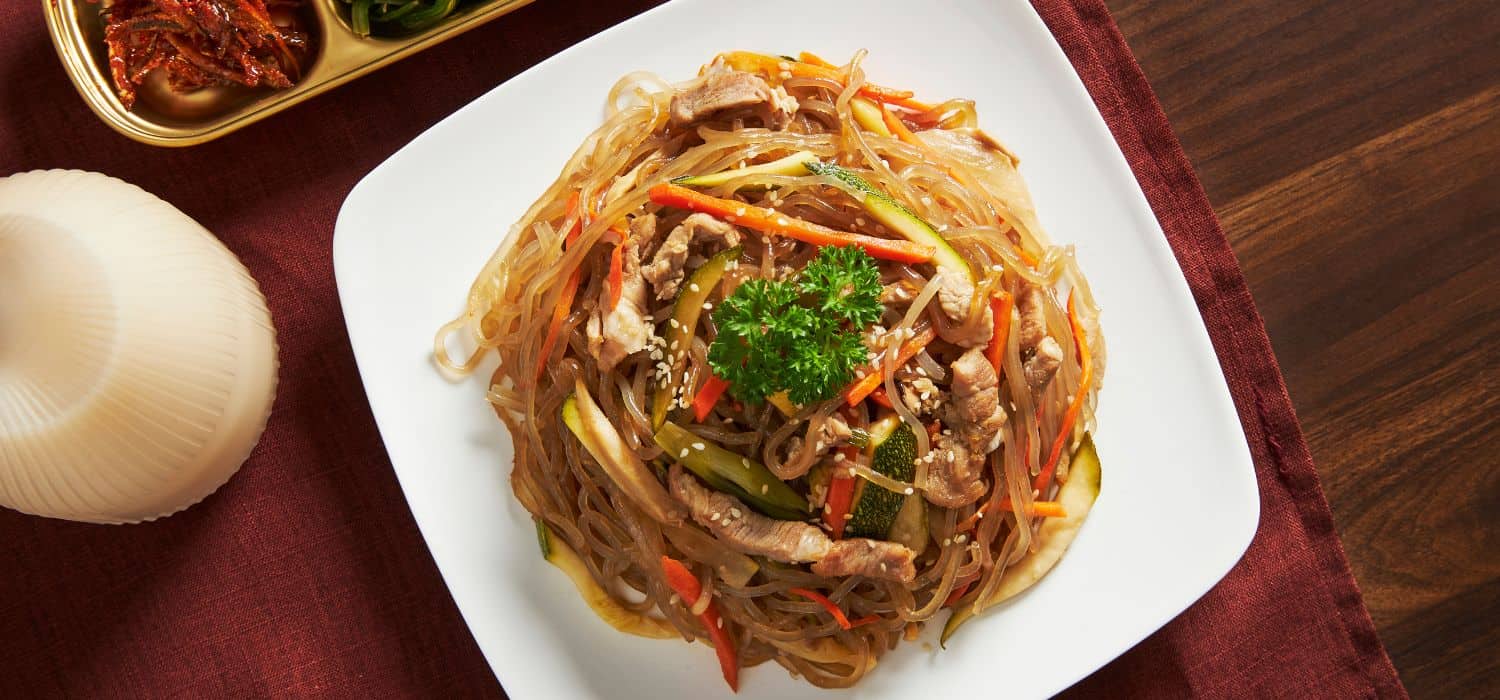
Jump to:
⌛ Historical Background of Japchae
Japchae has deep roots in Korean history. It originated in the 17th century during the reign of King Gwanghaegun of the Joseon Dynasty. The name japchae literally means "mixed vegetables."
The dish was first created for a royal banquet by Yi Chung, one of the king's lieutenants.
Initially, japchae didn't include noodles. It consisted solely of stir-fried vegetables. Over time, cellophane noodles made from sweet potato starch were introduced, transforming the dish into its modern form.
During the 1930s, the addition of beef became popular, enhancing the dish's flavor and making it more appealing.
Today, japchae is typically made with dangmyeon (sweet potato starch noodles), assorted vegetables, and sometimes meat. The vegetables are usually stir-fried with sesame oil, soy sauce, and a touch of sugar.
Japchae is not just a royal treat; it has become a staple in Korean food. It's often found in holiday feasts, special occasions, and daily Korean cooking. The dish exemplifies the harmony of textures and flavors that is central to Korean recipes.
🥕 Key Ingredients in Japchae
Glass Noodles: The Foundation
The main ingredient in japchae is dangmyeon, or Korean sweet potato starch noodles. These glass noodles are prized for their chewy texture and ability to absorb flavors. When cooked, they become translucent, adding a unique visual appeal to the dish.
To prepare, the noodles are typically boiled until soft, then quickly rinsed in cold water to stop cooking. They're stir-fried with the other ingredients, allowing them to soak up the rich flavors of the sauce. Dangmyeon can be found in most Asian grocery stores and provides the perfect base for this dish.
Vegetables: The Colorful Assortment
Japchae is vibrant with a mix of fresh vegetables like shiitake mushrooms, spinach, carrots, and onions. These vegetables not only add color but also different textures and flavors, making each bite interesting.
- Shiitake Mushrooms: Known for their umami flavor.
- Spinach: Adds a fresh, green element.
- Carrots: Offer sweetness and a bit of crunch.
- Onions: Provide a mild, sweet flavor when cooked.
These vegetables are usually julienned or thinly sliced, ensuring they cook quickly and evenly during the stir-fry process.
Proteins: Adding Savory Flavors
Japchae often includes proteins like beef, pork, or eggs, enhancing the dish's savory profile. The proteins are typically marinated in soy sauce, garlic, and a touch of sugar, infusing them with flavor before being stir-fried.
- Beef and Pork: Thinly sliced and marinated, these meats add a tender and juicy element.
- Eggs: Prepared as jidan (thin egg strips), they provide a soft texture and vibrant color.
For a vegetarian or vegan twist, tofu or extra mushrooms can replace the meat, ensuring everyone can enjoy this delicious dish.
The Japchae Sauce: Bringing It All Together
The japchae sauce is a blend of soy sauce, sesame oil, garlic, and sugar. This combination creates a savory-sweet flavor that ties all the ingredients together beautifully.
- Soy Sauce: Adds depth and umami.
- Sesame Oil: Provides a nutty aroma.
- Garlic: Enhances the overall flavor.
- Sugar: Balances the saltiness.
After combining the sauce with the noodles, vegetables, and proteins, a sprinkle of sesame seeds and a pinch of salt and pepper are added to finish the dish. This simple yet flavorful sauce ensures every bite of japchae is delicious.
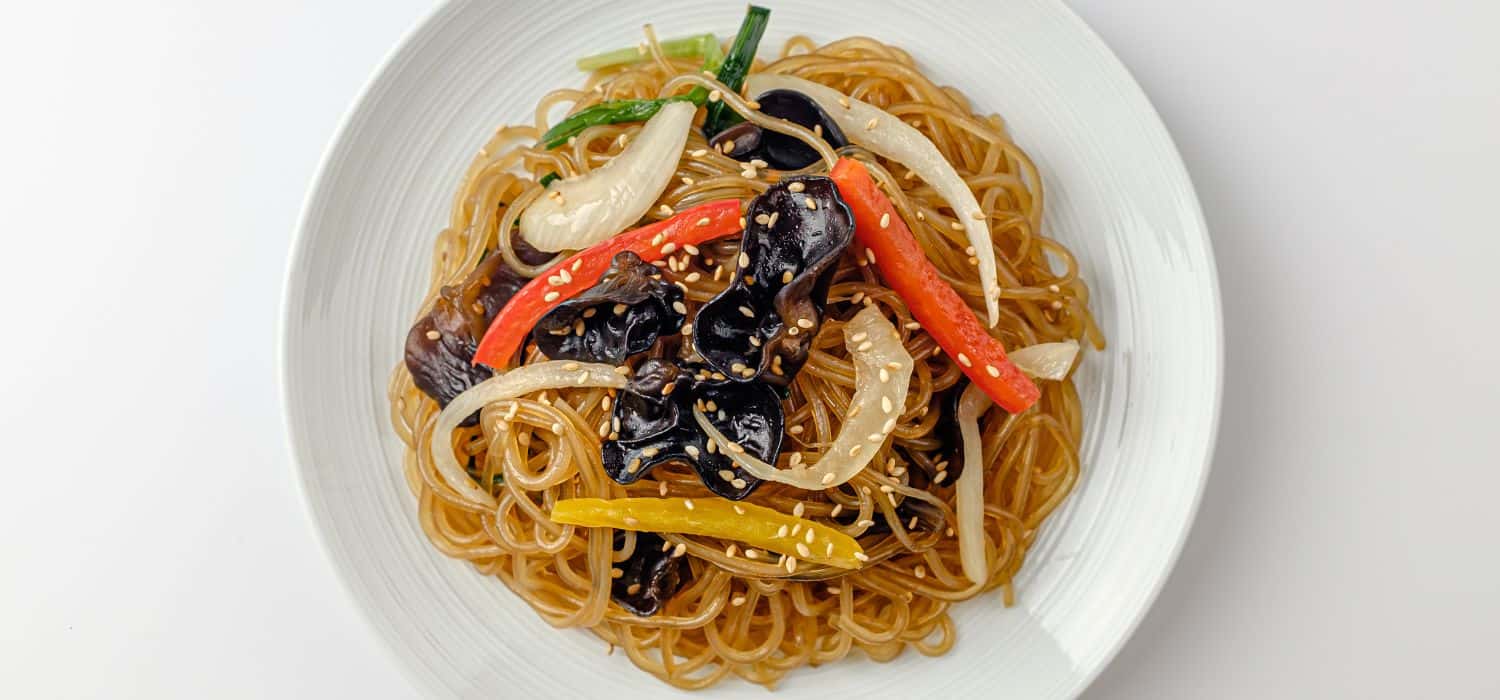
🥘 How to Make Japchae (Step-by-Step)
Boiling the Noodles
Start by boiling water in a large pot. Once boiling, add the Korean glass noodles and cook for about 5-10 minutes until they become soft but still chewy. Stir occasionally to prevent sticking.
After boiling, drain the noodles and rinse them in cold water to stop the cooking process. For easier handling, use kitchen shears to cut the noodles to your desired length, around 6-8 inches is common.
Stir-Frying the Ingredients
Heat a skillet or wok over medium-high heat. Add a small amount of oil and start by stir-frying minced garlic until fragrant. Then add your choice of vegetables such as carrots, bell peppers, and spinach.
For proteins, include options like beef or mushrooms. Stir-fry until everything is well-cooked but still crisp. This step helps lock in the flavors and keeps the vegetables vibrant.
Mixing and Seasoning
In a large mixing bowl, combine the boiled noodles with the stir-fried ingredients. Prepare the japchae sauce by mixing soy sauce, sesame oil, sugar, and freshly ground black pepper.
Pour this sauce over the noodles and vegetables. Mix well to ensure every ingredient is well-coated. Taste and adjust seasoning with salt and additional soy sauce if necessary. Finally, garnish with toasted sesame seeds for an added crunch.
🌟 Variations and Dietary Adaptations
Vegetarian and Vegan Options
For those wanting a vegetarian or vegan japchae, simply swap out the meat with tofu, tempeh, or a mix of mushrooms.
Marinate tofu or tempeh in a similar marinade as the beef marinade to get rich flavors. For extra nutrients, add more veggies like bell peppers, zucchini, and spinach. Ensure the soy sauce used is vegan-friendly, as some may contain fish products.
Protein Variations
Traditional japchae often uses beef, but there are many other proteins you can incorporate. Chicken, shrimp, and pork are excellent alternatives. Each protein has its distinctive marinade needs.
For chicken, consider using Korean soy sauce and a bit of honey. Pork can benefit from a marinade with brown sugar instead of white sugar. Remember to adjust cooking times to ensure the meat is properly cooked.
Adjusting the Sweetness and Savory Levels
Japchae’s unique flavor balances sweet and savory. To adjust sweetness, you can experiment with different sweeteners. Brown sugar, honey, or agave syrup can add a deeper sweetness than white sugar.
If you want a more savory dish, increase the soy sauce or add more garlic and black pepper. It's important to taste and adjust gradually to avoid overpowering the dish.
By understanding and applying these variations, you can enjoy japchae that fit your dietary needs and personal preferences. From a vegan twist to experimenting with different proteins, there are endless ways to enjoy this delicious Korean dish.
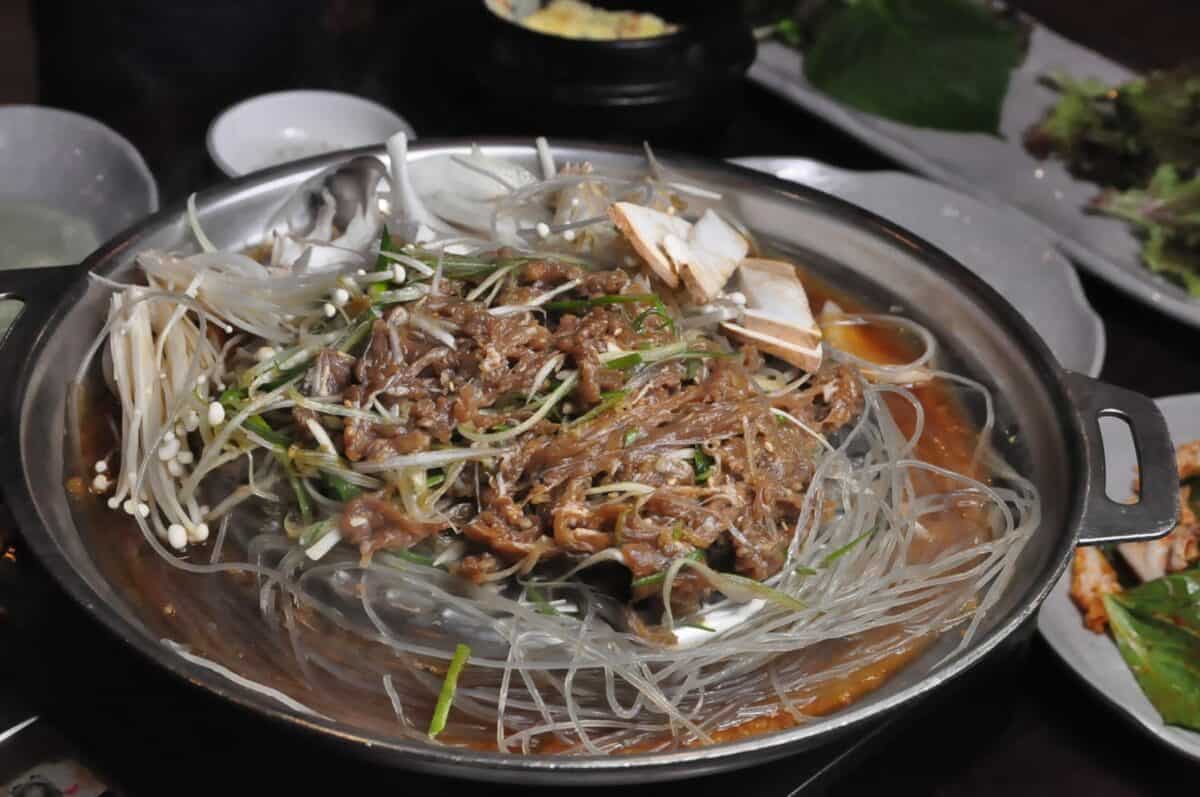
🍱 Plating and Garnishing Tips
Serving Japchae as a Main or Side Dish
When serving japchae as a main dish, use a large, flat platter. This creates an open display that showcases the rainbow of vegetables and glass noodles. For individual servings, try deep bowls or plates with a wide rim to provide enough space for noodles and garnishes.
As a side dish, smaller dishes or even ramekins work well. This way, the japchae complements the main entrée without being overwhelming. Be sure to keep the portions smaller and place them neatly to maintain elegance. Let the noodles drape lightly over the sides.
Garnishing for Visual Appeal
To make japchae visually appealing, colorful vegetables are key. Think julienned carrots, spinach, red bell peppers, and mushrooms. Scatter these veggies evenly to create a balanced look.
For an extra pop, add an egg garnish on top. Thin egg strips or even a fried egg can add a nice touch. Toasted sesame seeds sprinkled over the noodles bring texture and a lovely aroma. Scallions sliced thinly can add freshness and a bit of green color.
Arrange everything in layers to create depth and avoid clumping similar colors together. This ensures each bite offers a mix of flavors and textures, making your japchae delicious and a feast for the eyes.
❄️ Storing and Reheating Leftovers
Storing Japchae
- Refrigerator: Place your japchae in an airtight container. It can last up to 3 days in the fridge.
- Freezer: For longer storage, freeze japchae in an airtight container for up to 2 months.
Reheating Japchae
- Skillet: Add a drizzle of sesame oil to a skillet. Heat on low and add your japchae. Stir continuously for 3-5 minutes until warm. This method keeps the noodles' texture chewy.
- Microwave: Place japchae in a microwave-safe dish and cover with a damp paper towel. Microwave on medium for 1-2 minutes, stirring halfway through.
Tips
- Avoid overcooking: Overheating can ruin the texture of the noodles.
- Freshen flavors: Add a bit of fresh soy sauce or sesame oil to enhance the dish after reheating.
Frequently Asked Questions
To make with beef, thinly slice flank steak and marinate it in soy sauce, sugar, garlic, and sesame oil. Stir-fry the beef until it's done, then mix with cooked glass noodles and vegetables like bell peppers, carrots, and spinach.
A traditional japchae recipe includes sweet potato starch noodles, beef, or other protein, a variety of vegetables like carrots, spinach, onions, bell peppers, soy sauce, garlic, sugar, and sesame oil.
Japchae can be healthy, especially when packed with a variety of vegetables. The noodles are gluten-free and made from sweet potato starch. It's important to balance the sauce to avoid too much sugar or sodium. Overall, it's a nutrient-rich option.

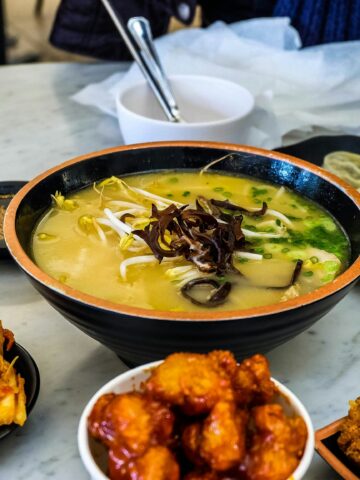
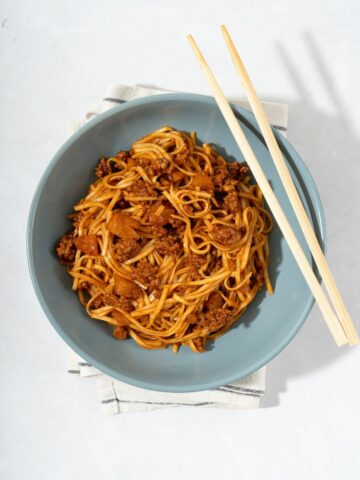

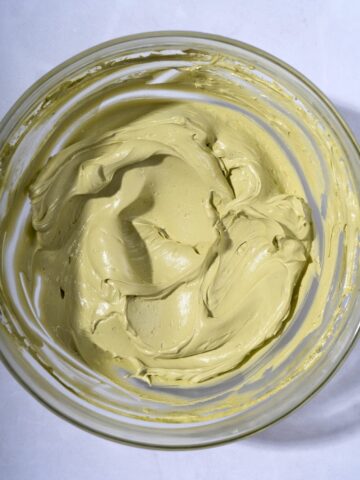
Comments
No Comments